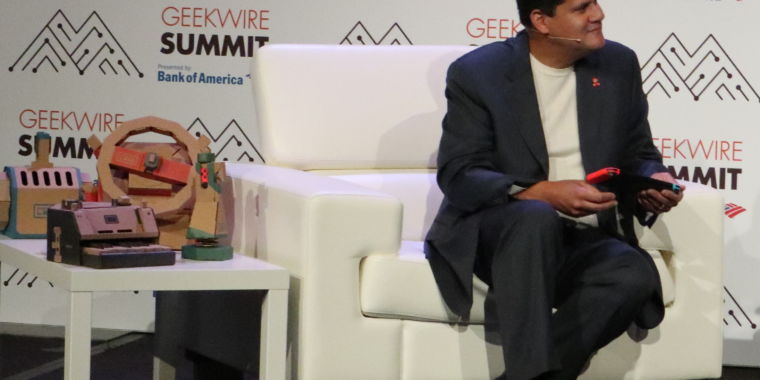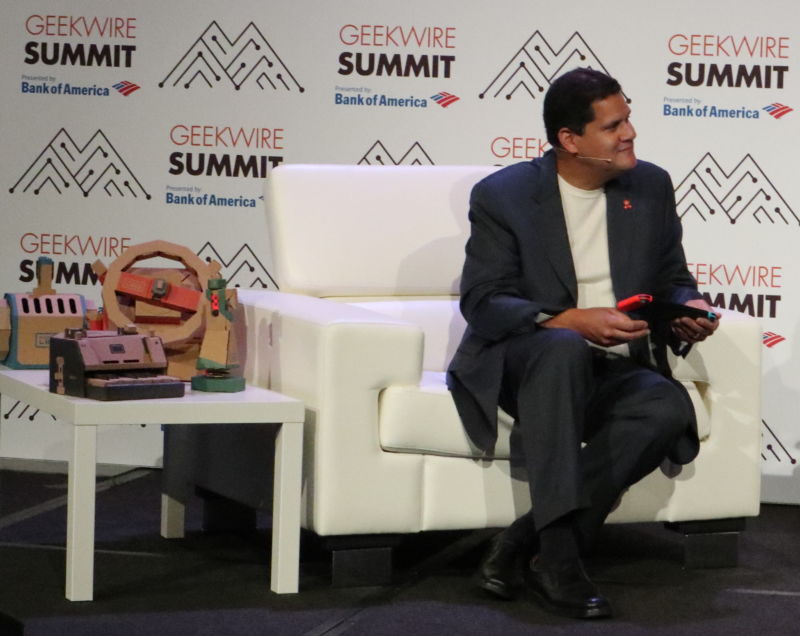

/ Nintendo of America President and COO Reggie Fils-Aime poses with the wildly successful Nintendo Switch.
Sam Machkovech
SEATTLE—Nintendo of America President and COO Reggie Fils-Aime appeared at Seattle’s Geekwire Summit on Wednesday to speak broadly about the company’s future, and, while the talk didn’t include new product reveals, it proved illuminating about what to expect from the big N in the future.
The short version: Nintendo would rather be defined as an “entertainment” company, not a gaming one.
Fils-Aime says the company currently has three “pieces of business”: a dedicated video game business (“the way most of our consumers interact with us”), a mobile gaming business, and “leveraging our intellectual property (IP) in a variety of ways.” The latter includes previously announced plans for a Universal Studios attraction in Osaka, Japan (still slated to open ahead of Tokyo’s next Olympics hosting run in 2020) and a Super Mario film produced by Illumination Entertainment (Minions, Despicable Me).
When asked by the moderator, Geekwire’s Todd Bishop, about Nintendo’s future focus on a company-wide level, Fils-Aime pointed to conversations he recently had with attendees of a GameStop corporate conference, during which GameStop staffers described their favorite classic games (and showed off related tattoos). “It’s about Mario, Zelda, Pokemon—all these wonderful intellectual properties,” Fils-Aime said. “How we leverage these across a variety of entertainment platforms is how we’re looking to grow the company.”
In Wednesday’s Q&A session, Fils-Aime used the term “intellectual property” no less than 15 times, and he emphasized Nintendo’s work outside the Switch and 3DS ecosystems as major drivers of Nintendo to come. As an example, he mentioned Super Mario Run being downloaded by hundreds of millions of smartphone users. “That’s our vision for mobile: to deliver our intellectual property in compelling ways to consumers who may not have experienced those properties before. A belief that they’ll come back, maybe buy a Mario T-shirt, eat that Mario cereal, or buy a Switch, because of affiliation and affection they have with that IP.”
When asked about how long Nintendo took to embrace smartphone platforms, Fils-Aime admitted that the company’s slow mobile rollout—and lack of direct ports of classic games—was intentional. “We needed to create unique experiences,” Fils-Aime told the Seattle crowd. “Home system games, if transplanted to a mobile device, wouldn’t transfer as well. We needed to work through monetization… as we’re driven to make money. And we needed to work through how to be effective on platforms and marketplaces that we ourselves don’t own. That took time.”
Bishop directly asked Fils-Aime about issues that Nintendo Switch Online users are facing with its peer-to-peer approach to online gaming as opposed to connecting to central servers. Fils-Aime did not answer this question and instead offered his take on why the service relies on a smartphone app for voice communication: “Nintendo’s approach is to do things differently. We have a much different suite of experiences than our competitors offer, and we do that in a different way. This creates a sort of yin and yang for our consumers. They’re excited about cloud saves and legacy content but wish we might deliver voice chat a different way, for example.
“What we see is a situation where we know that Nintendo Switch is being played in the open, at a park, on a metro bus,” he continued. “We believe the easiest way for you to connect and have a peer-to-peer experience with voice chat is with your mobile phone. It’s always there, it’s always with you.”
“Minute by minute”

/ Nintendo of America President and COO Reggie Fils-Aime demonstrates how Switch hardware fits into Nintendo Labo’s cardboard playsets. He didn’t take the opportunity to reveal any specific sales data about the add-on series.
Sam Machkovech
Yet in spite of this comparison to other game-hardware producers’ services, Fils-Aime answered the question of whether he saw Xbox and PlayStation as competitors with a flat “I don’t.”
He counted the exact number of minutes per day and said that outside of the time a consumer spends eating, sleeping, working, and going to school, “all of the rest of that time is entertainment time. That’s what I compete for, minute by minute. That time you spend surfing the Web, watching a movie, watching a telecast of a conference: that’s all entertainment time we’re competing for. My competitive set is much bigger than my direct competitors in Sony and Microsoft. I compete for time. When I do that, I have to be creative and innovative in order to win that battle.”
Bishop asked Fils-Aime to look back at the Wii U, and Fils-Aime was frank about its issues: “Without Wii U, we would not have the Nintendo Switch, in terms of what we learned and, importantly, what we heard from our consumers. They told us, ‘I want to play with this gamepad on the Wii U, but as soon as I get more than 30 feet away, it disconnects.’ The core concept of taking it any time, that was compelling.”
Fils-Aime offered a peek at his first-blush experience with the Switch, which actually came from holding a basic, plastic shell. “It was a moment where the hair on the back of my neck raised,” Fils-Aime said. “The same way I felt when I first held the Wii remote, the same way I felt when I saw the inner-workings of a Nintendo DS. With that moment, we knew we had a compelling proposition.” He clarified that this shell version of the Switch was meant “to simulate how it felt in my hand, the core concept. Our engineers had to execute it. Our developers needed to create compelling content to bring it to life. We’re fortunate we did that.”
“Without Wii U, we would not have the Nintendo Switch.”
When asked about technologies we might see from Nintendo in the future, Fils-Aime responded to a specific question about augmented and virtual reality possibilities. After reminding the crowd about Nintendo’s history with the Virtual Boy and an “AR Cards” feature baked into the 3DS, he offered the most intriguing official line from the company yet: “This is something we constantly think about, experiment with. For virtual reality, we’ve said: it’s tech that we’re looking at, but in the end it has to be fun. That’s our mission, and that is what we do arguably better than anyone else. We have nothing to announce here on this stage. These are going to be technologies that we’ll continue to experiment with. There are new experiences we want to bring to life.”
(He later noted Nintendo’s emphasis on new technologies and twists on existing ones, including standard analog joystick controllers and the DS’s touchscreen, before adding, “We’d love to see more of this tactile experience, between interactive experiences and the touch and feel of something in real space.” This statement was not connected by either Fils-Aime or Bishop to what had already been said about possible AR and VR products from Nintendo.)
Other tidbits included Fils-Aime confirming several things: that his famous E3 speech (“I’m about taking names, and we’re about making games”) was carefully crafted by the worldwide Nintendo team, particularly through “constant communication with our global president at the time, Mr. Iwata”; that he personally meets with “every group of new employees” to deliver an introduction of the company’s philosophies and strategies; and that the company’s first reveal of a Zelda game on the Wii, at E3 2006, was indeed footage of what eventually became Twilight Princess (and that, according to Fils-Aime, the sequence “literally made people cry”).








